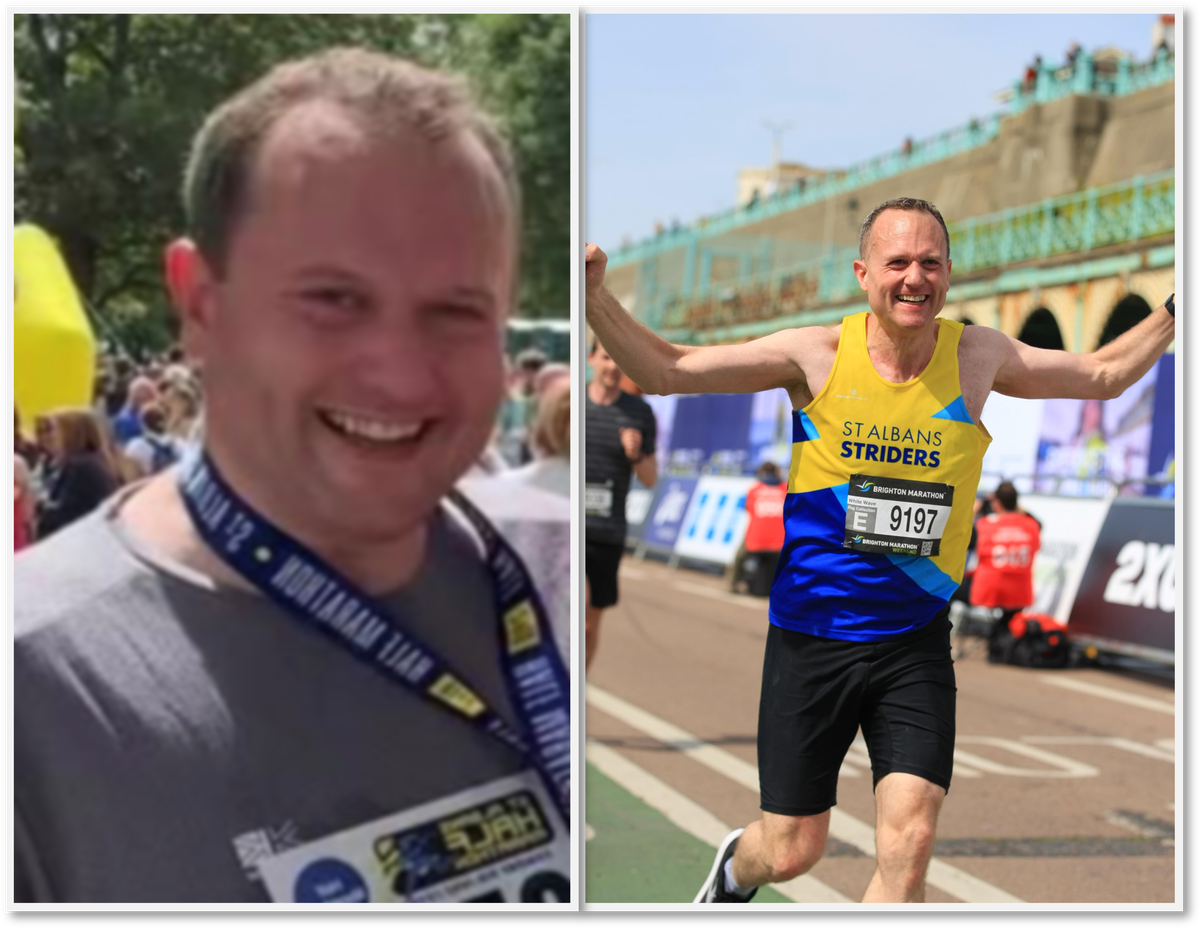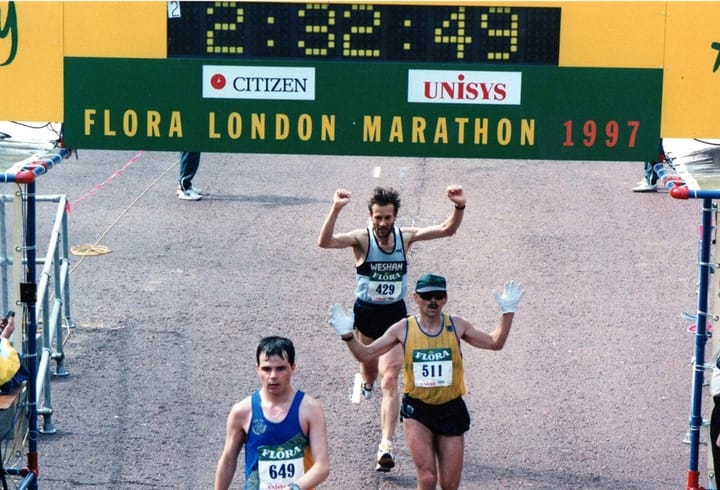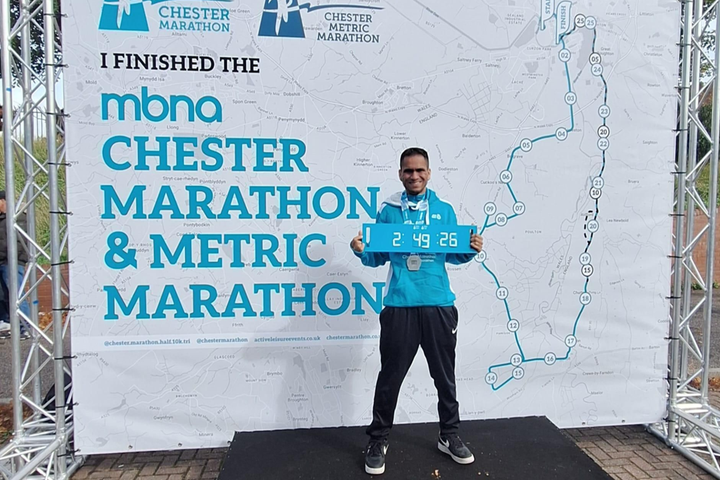How I went from being obese to running sub-3 in 12 months
A year after hitting my heaviest weight, I ran a sub-3 marathon. This is the journey, the lessons, and the mindset that made it possible.

In February 2021, just after my 41st birthday, I hit a wall. Lockdown had eroded every last thread of routine. I was only allowed out for an hour a day, and usually went walking with my young son—so running had disappeared. Like many people during that time, I turned to comfort: takeaways (often twice a week), red wine deliveries that arrived a little too often, and any lingering pretence of healthy habits gave way. I abandoned even the skimmed milk in favour of full-fat.
One evening, after a pizza-heavy dinner, I experienced heart palpitations. The next morning, my resting heart rate had hit 74bpm. It was a wake-up call. Covid seemed to punish the unhealthy. And I had a three-year-old son I needed to be there for. I decided then and there that March would be different. Something drastic had to change.
I began by buying a set of scales—the first time I'd weighed myself in ages. The number staring back at me was 114 kilograms. I'm tall (186cm), but that was firmly in obese territory. This didn’t come as much of a surprise, having recently upgraded to 100cm waist trousers (40inches). I signed up to Noom, an app that a few colleagues had used with good results. It offered a blend of calorie tracking, gentle psychology, and daily quizzes. Some of it felt a bit fluffy, but I committed to the process. I'd tried quick-fix diets before - the cabbage soup diet, "fat-burner" regimes - and any weight loss lasted a matter of weeks. This time, I knew it had to be different.
Lockdown, ironically, helped. Without business dinners, travel, or social occasions, it was easier to build new routines. My wife supported me, and the daily weigh-ins that Noom encouraged were quietly motivating. The weight came off fast. I was losing around five kilos a week early on.
I quickly realised running would be my ally in this venture, and not just because Noom lets you eat more if you exercise!
Running wasn’t new to me. My parents were marathon runners. Some of my earliest memories are of cheering them on at the London Marathon in the 1980s. My mum always bought me Brooks running shoes for Christmas. But in those early months of 2021, I felt ashamed of how I looked. I'd jog to a nearby field and run loops of the perimeter, hoping nobody would see my belly wobbling. It was about movement, not performance.
The shift came slowly. On Good Friday, I heard the faint sound of a tannoy from another field - a local 10K was taking place. It stirred something. As I got fitter, I began running natural fartleks, sprinting short sections of my usual loop. Subconsciously, the fire was coming back. Years earlier I’d once run a 40:20 10K. I wondered whether sub-50 might be realistic now.
That summer, I signed up for the St Albans 10K. I ran it in 44 minutes. By then, I’d dropped to around 82kg (31 inch waist) and passed a BUPA health check with flying colours. One doctor told me, "If everyone we saw was as healthy as you, we’d be out of a job." Quite a contrast to the doctor a couple of years earlier who said to me, curtly, as I walked into her office, "well the first thing I can see is that you're very overweight".
Back at work, some erstwhile colleagues didn’t recognise me. One spoke to me for two minutes before realising who I was. People who only met me during Zoom-era work assumed I’d always been lean. But I wasn’t. I still look at old photos and feel shocked. Even my son barely recognises them. My resting heart rate is now around 48. Back then, it was over 70. That’s 35 fewer beats per minute. Or over 50,000 fewer heartbeats every day.
The 10K result lit a fire. I got close to sub-40 twice, then joined the St Albans Striders running club. Wearing the vest gave me a sense of pride and accountability. In September, I ran the Stevenage 10K in 38:49 and came 8th. It wasn’t just about weight loss anymore—I’d caught the racing bug. The following month, I went on to run a half marathon in 82:40, smashing my previous PB by 12 minutes. The marathon was the next logical step.
I started training seriously. My father, a sub-3 marathoner in the early 1990s, had a well-thumbed copy of The Competitive Runner’s Handbook. I skipped straight to the "Champion" plan and embraced high mileage. I also joined Strava, encouraged by a cycling colleague, and began absorbing the social aspect of training -comparing efforts, seeing what others were doing. It helped me stay accountable.
That autumn, I ran marathon distances in training to hit my weekly mileage goals. On one such run, I clocked 3:19 without really pushing. I knew sub-3 was a real possibility.
With London out of reach, due to the ballot, I picked Brighton. It meant something personal: the marathon starts in Preston Park, near the home of a close friend who had recently died. I framed it as a short holiday for the family and a personal challenge for me.
Race day was cool and sunny. Because of my half marathon time, I qualified for the elite start. I took a hot bath that morning, ate a bagel and jogged the two miles to the start line. The first kilometre passed my late friend’s house, and I couldn’t help but remember saying goodbye to him, then running through the park with tears in my eyes. Running was the only thing that made grief bearable.
But the race itself was joyous - a carnival through central Brighton, with people lining the streets and cannabis hanging faintly in the air (not inhaling too much is tricky during a marathon!) I settled into a strong rhythm and felt in control, even on the hills. Around mile 20, the course veered into a bleak industrial stretch. My legs began to cramp slightly. But I hit 20 miles in 2:10 and knew I had just under 50 minutes to run the final 10K. I could do that. I chose not to chase 2:50 and risk blowing it. I consciously dropped my pace and crossed the line in 2:57:57.
My wife and son were at the finish. I had a non-alcoholic Erdinger, then sat with them on Brighton’s stony beach, watching the waves. Later came the Strava kudos, the messages from family, the quiet glow of a goal realised. It was a beautiful afternoon.
In that moment, I felt like a new person. The man who ran loops in secret was gone. So was the man drinking full-fat milk and ordering wine deliveries twice a month. This wasn’t about aesthetics anymore. I was focused on performance. The Brighton time got me a good-for-age place in London. And yes, I would go on to break 2:50 - and get a podium place in that Good Friday 10K that originally piqued my interest in racing.
That day, I ran in Brooks Hyperion Tempos. No carbon plates, just light shoes and a high cadence - a hangover, perhaps, from once carrying 114kg around. At the time, I didn’t even know Vaporflys could be used by "normal" runners.
After the race, I had my first alcoholic drink in months: a punchy Negroni. It didn’t sit right. A few years later, I gave up alcohol altogether in the pursuit of a sub 2:40 (but that’s another story).
This transformation didn’t come from Ozempic or any shortcut. It came from structure, willpower, and running. There were moments I could have quit - minor injuries, wobbles, hunger pangs - but I didn’t. Once you go sub-3, no one can take it away from you. You’re a sub-3 marathoner for life.
If you’re sitting where I was in February 2021, know this: it is possible. It is worth it. A thousand times over.
⸻
Five Key Things to Consider if You’re Overweight and Planning to Run a Sub-3 Marathon
1. Shedding excess weight will make you faster — full stop.
If you’re overweight or obese, losing fat mass significantly improves running economy, reduces injury risk, and boosts your speed per heart beat. It won’t do the job alone — but it’ll help more than almost anything else.
2. Focus on performance, not appearance.
This isn’t about looking good in race photos. It’s about feeling strong on hills, holding pace at mile 20, and recovering well. Let performance be your driver — aesthetics are just a by-product.
3. Start where you are — not where you were.
Don’t judge early runs by past glories. You might be slower, heavier, or more self-conscious. But that’s temporary. Focus on getting moving, building consistency, and letting confidence return through action.
4. Build structure, not shortcuts.
Forget crash diets or magic gear. What works is sustained change: smart fuelling, steady mileage, sleep, strength work, and supportive routines. Those changes stack up. And they stick.
5. Sub-3 is possible — and the journey is transformative.
Crossing the line under three hours is extraordinary. But so is becoming the kind of person who can do it. The weight you lose is real. But so is the strength you gain — in body, mind and resolve.
Enjoyed this article? Help keep Sub-3 running — support us with a coffee.
To help fund the running of the site, Sub-3 is an Amazon Associate and earns from qualifying purchases. We only recommend gear or kit that has genuinely helped in our own running and that we believe is worth considering.



